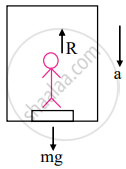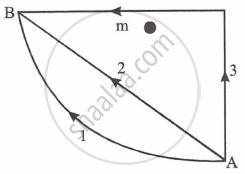Advertisements
Advertisements
Question
Solve the following problem.
As I was standing on a weighing machine inside a lift it recorded 50 kg wt. Suddenly for a few seconds, it recorded 45 kg wt. What must have happened during that time? Explain with complete numerical analysis.
Solution
The weight recorded by the weighing machine is always apparent weight and a measure of reaction force acting on the person. As the apparent weight (45 kg-wt) in this case is less than actual weight (50 kg-wt) the lift must be accelerated downwards during that time.
Numerical Analysis
- The weight on the weighing machine inside the lift is recorded as 50 kg - wt
∴ mg = 50 kg - wt
- This weight acts on the weighing machine which offers a reaction R given by the reading of the weighing machine
∴ R = 45 kg-wt = `9/10` mg - The forces acting on the person inside the lift are as follows:
a. Weight mg downward (exerted by the earth)
b. Normal reaction (R) upward (exerted by the floor) - As, R < mg, the net force is in downward direction and given as,
mg - R = ma
But R = `9/10`mg
∴ mg - `9/10` mg = ma
∴ `"mg"/10 = "ma"`
∴ a = g/10
∴ a = 1 m/s2 (∵ g = 1 m/s2) - Therefore, the elevator must be accelerated downwards with an acceleration of 1 m/s2 at that time.
APPEARS IN
RELATED QUESTIONS
Answer the following question.
In the following table, every entry on the left column can match with any number of entries on the right side. Pick up all those and write respectively against A, B, C and D.
| Name of the force | Type of the force | ||
| A | Force due to tension in a string | P | EM force |
| B | Normal force | Q | Reaction force |
| C | Frictional force | R | Conservative force |
| D | Resistive force offered by air or water for objects moving through it. | S | Non-conservative force |
Find the odd man out:
Answer the following question.
You are sitting next to your friend on ground. Is there any gravitational force of attraction between you two? If so, why are you not coming together naturally? Is any force other than the gravitational force of the earth coming in the picture?
Answer the following question.
Distinguish between real and pseudo force.
Answer the following question.
Distinguish between conservative and nonconservative forces.
Answer the following question.
State the formula for calculating work done by a force. Are there any conditions or limitations in using it directly? If so, state those clearly. Is there any mathematical way out for it? Explain.
Solve the following problem.
Power is the rate of doing work or the rate at which energy is supplied to the system. A constant force F is applied to a body of mass m. Power delivered by the force at time t from the start is proportional to ______.
Derive the expression for power in terms of F, m, and t.
Solve the following problem.
Derive the expression for power in terms of F, m, and t.
Solve the following problem.
Two galaxies of masses 9 billion solar mass and 4 billion solar mass are 5 million light-years apart. If, the Sun has to cross the line joining them, without being attracted by either of them, through what point it should pass?
Solve the following problem.
While decreasing linearly from 5 N to 3 N, a force displaces an object from 3 m to 5 m. Calculate the work done by this force during this displacement.
Variation of a force in a certain region is given by F = 6x2 – 4x – 8. It displaces an object from x = 1 m to x = 2 m in this region. Calculate the amount of work done.
Two bodies A and B of equal mass are suspended from two separate massles springs of force constant k1 and k2, respectively. The bodies oscillate vertically such that their maximum velocities are equal. The ratio of the amplitudes of body A to that of body B is ______.
If W1, W2 and W3 represent the work done in moving a particle from A to B along three different paths 1, 2 and 3 (as shown in fig) in the gravitational field of the point mass 'm'. Find the correct relation between W1, W2 and W3.

In air, a charged soap bubble of radius 'R' breaks into 27 small soap bubbles of equal radius 'r '. Then the ratio of mechanical force acting per unit area of big soap bubble to that of a small soap bubble is ______.
Which of the following is the correct order of forces?
What is the amount of work done by a person when
- he holds a mass of 2 kg for 5 second and
- he lifts the same mass through 1 meter to keep it on the top of a table? g = 9.8 m/s2
A force F = (10 + 0.5 x) N acts on a particle in the x-direction. The work done by the force in displacing the particle from x = 0 to x = 2 metre is ______.
'n' number of balls each having mass 'm' and velocity 'u' hit a wall elastically and normally in 2 seconds. The force exerted by them on the wall is ______.
Out of the fundamental forces in nature, maximum and minimum range is respectively for ______.
Two rods of same length and transfer a given amount of heat 12 second, when they are joined as shown in figure (i), But when they are joined as shown in figure (ii), then they will transfer same heat in same conditions in ______.


A gardener pushes a lawn roller through a distance of 20 m. If he applies a force of 30 kg-wt in a direction inclined at 60° to the ground, the work done by the gardener in pushing the roller is ______.
`["g" = 9.8 "m""/""s"^2, sin30^circ = cos60^circ = 1/2, cos30^circ = sin60^circ = sqrt3/2]`
Which of the following statements is correct?
